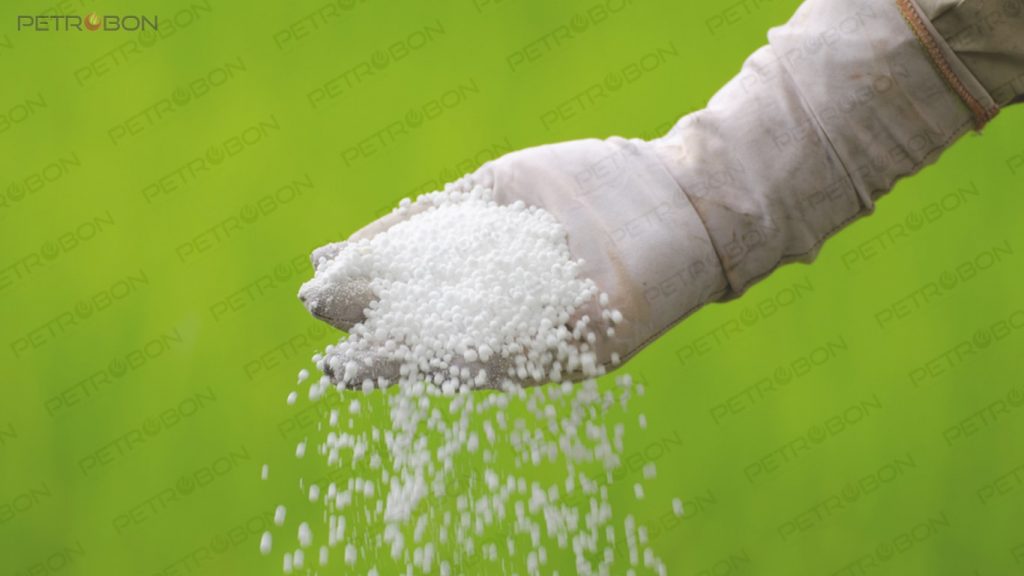Urea (CO (NH2)2) is the most widely used solid N fertilizer in the world. Urea is also commonly found in nature since it is expelled in the urine of animals. The high N content of urea makes it efficient to transport to farms and apply to fields.
Production of Urea
The production of urea fertilizer involves controlled reaction of ammonia gas (NH3) and carbon dioxide (CO2) with elevated temperature and pressure. The molten urea is formed into spheres with specialized granulation equipment or hardened into a solid prill while falling from a tower. During the production of urea, two urea molecules may inadvertently combine to form a compound termed biuret, which can be damaging when sprayed onto plant foliage. Most commercial urea fertilizer contains only low amounts of biuret due to carefully controlled conditions during manufacturing. However, special low-biuret urea is available for unique applications. Urea manufacturing plants are located throughout the world, but most commonly located near NH3 production facilities since NH3 is the major input for urea. Urea is transported throughout the world by ocean vessel, barge, rail, and truck.
Non-agricultural Use of Urea
Urea is commonly used in a variety of industries. It is used in power plants and diesel exhaust systems to reduce emission of nitrous oxide (NOx) gases. Urea can be used as a protein supplement in the diet of ruminant animals, such as cattle. Many common industrial chemicals are made using urea as an important component. Urea can be used to produce Urea nitrate, a high explosive which is used industrially. Urea-containing creams are used as topical dermatological products to promote rehydration of the skin.
How to use Urea
Urea reacts with the water in the soil immediately after application through a biological process called hydrolysis. The urea is converted to ammonium carbonate which can quickly transform into ammonia gas. If the ammonia is not captured and converted to ammonium (NH4+) quickly after it is formed, ammonia will be lost into the air. Soil pH, soil temperature, soil moisture, placement of the urea, wind speed, soil chemical and biological properties, and timing and amount of rain or irrigation all influence the percentage of N lost through volatilization. Ammonia gas loss increase greatly over 60° F. At temperatures below 45 degrees Fahrenheit ammonia loss is limited. High moisture conditions common during early spring and late fall can increase volatilization risk of surface-applied urea. Ammonia gas losses from surface-applied urea increase in windy conditions. Soils with a large cation exchange capacity (CEC) can retain more ammonium, reducing the chance of loss of N through volatilization. If no rain occurs after application and the urea is not incorporated, N loss can be significant. As rainfall or irrigation increases more urea from the surface moves into the soil profile.
Urea suppliers and consumers
Asia’s share of global nitrogen consumption was 60% in 2016, with China representing approximately half of that share. The highest growth rates going forward are expected to be seen in sub-regions with recovering agriculture such as Eastern Europe and Central Asia, and in regions with a large potential to increase agricultural production. Latin America falls into the latter category, and although it still accounts for a relatively small volume, the region is expected to keep its position as the region with the highest growth rate. Consumption in mature markets like North America and West Europe is forecast to grow at a slower pace, while Chinese consumption is expected flat over the next years.
Urea production increased to 174.3 million tons in 2016, down 0.6% from 2015. During the years 2006-2016, urea production had a trend growth at 2.8% per year. The largest producers are also the largest consumers, namely China and India. China is self-sufficient on nitrogen fertilizer but India’s imports requirement is substantial. Most of the new nitrogen capacity in the world is urea, so it is natural that production/consumption growth rates are higher for urea than for ammonia/total nitrogen. Lately, the difference has been quite large, since urea has taken market share. As urea has a high nitrogen content (46%), transport is relatively inexpensive compared with other products.
Iran Urea
Iran’s urea exports in 2018 increased 26% year on year to nearly 4.2m tones, despite US sanctions, according to data from The Islamic Republic of Iran Customs Administration via Trade Data Monitor (TDM).
The increase was due to higher production in the country and the initial limited impact of US sanctions, which were imposed on 6 August 2018, with the final deadline effective 4 November 2018.
The main destination for Iranian urea in 2018 was India, at 1.9m tones, followed by Turkey at nearly 400,000 tones.Over 800,000 tones was exported from Iran to China in 2018.
Pardis Petrochemical Co., Shiraz Petrochemical Co. Khorasan Petrochemical Co. and Kermanshah Petrochemical Co. produce Urea in Iran. Furthermore, Lordegan Petrochemical Co. will be the major urea producer in Iran in 2020.


